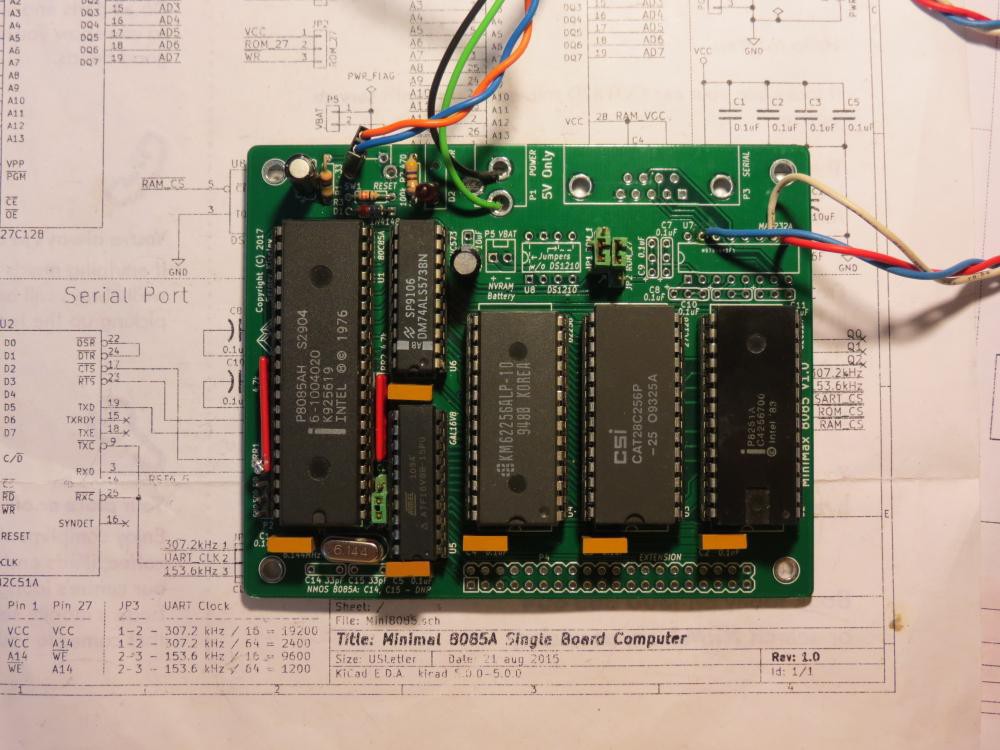-
Shelving this project
07/09/2020 at 01:18 • 0 commentsI was not able to get this board to boot. I may have faulty GALs, they don't seem to read back the same after programming, and I've been loath to debug the problem. Keith has successfully assembled this board so it's my problem, not the design. It seems he intends to improve the design, so I'll watch that with interest for something to do with 8085s. Also Craig's 8085 SBC.
The real problem is that I'm dissatisfied with the design of this board. It doesn't have any onboard GPIO, if you don't count the RIM and SIM pins, or my hack to use some modem pins. So it isn't great for driving stuff. Running Basic or CP/M on it gets old quickly.
So regretfully, maybe even with relief, I'm shelving this project. At least I learnt other things while trying this out.
I still have 7 unpopulated boards and can give you one if you pay postage from Australia.
-
Assembled a board
07/19/2019 at 13:59 • 0 commentsSpurred by interest by readers I finally got off my backside and soldered one board. Then I did an inspection of the joints with a magnifying glass in case there were any missed or bad joints. I did a short circuit test between adjacent pins of the sockets. I also did a continuity test from the IC sockets to the pads. I found one pin bent under the socket. Fortunately I was able to reach under with the soldering iron tip and deposit enough solder to join the bent pin with the pad. Better a little effort now than troubleshooting later.
To start with I will use a 28256 32kB EEPROM so that I can modify the firmware easily. The board also accepts 16kB EPROMs with a change of jumpers.
I have installed a 62256 32kB SRAM. A 6264 8kB SRAM could also be used. The difference is that for the top 2 address pins, A14 goes to NC, and A13 goes to Enable 2, which means that the 8kB will appear at both [0xA000,0xBFFF] and [0xE000,0xFFFF]. So it's just a matter of placing the RAM area the firmware uses in the appropriate 8kB interval.
I have to verify the GAL. I think I used the image for 6.144 MHz crystal but it's easy to burn the right one if I didn't.
Instead of using a MAX232A RS-232 level converter chip, I have elected to use a USB to TTL converter, readily available for a dollar or two. So I have soldered leads directly to the appropriate holes of the MAX232A.
The RAM backup is optional and won't be used.
I soldered a two pin header for the reset pins to which I can plug a lead to a NO push button switch.
Instead of using a barrel connector for power, I have soldered power supply leads. I don't understand this obsession with barrel connectors for 5V power. A more logical choice would be a micro USB connector which can take a cable from a 5V USB power supply. Many people have spare phone chargers which can be turned into project power supplies. Did you know that micro USB connectors are rated for a large number of insertions, think of all the times people plug their phone to charge, so are quite sturdy?
![]()
Look at the age of those chips! So now I have to work up the courage to connect up a LED, fetch the blink program, burn it into the EEPROM, and power up.
-
Programmng the GAL
03/17/2019 at 10:56 • 0 commentsNo no, not your wife/partner/girlfriend, you can't program those, they have minds of their own. Actually this is not even my joke, it's in the GALasm documentation, see further down.
The GAL used is a 16V8 which is way way obsolete but still readily obtainable for a dollar or two. Here's an old tutorial on how to use them. Really I don't know why people don't use them more to replace a whole bunch of TTL or CMOS logic. For one thing if you make a logic error you only need to fix the equations and reprogram, not rework a whole bunch of ICs and connects. For more complicated logic there are CPLDs and FPGAs which are used by many projects on Hackaday.
One thing though, to program these GALs you need a hardware programmer. The popular TL866 programmer, besides doing (E)EPROMs, and many MCUs, also handles the 16V8.
A compiler takes logic equations and generates JEDEC files which are written into the GAL. You don't need a compiler if the project supplies precompiled JEDEC files. But I wanted to learn to use such a tool for future reference. The compiler I used is the open source GALasm at Github. I found and fixed some issues with the code that provoked warnings from recent gcc versions and submitted a pull request, which the current maintainer gracefully accepted.
I have successfully programmed and verified a GAL. So that's the second goal accomplished. But bear in mind, I have not soldered a single joint or powered up anything yet. The true test is yet to come.
-
Getting the PCB fabricated
03/17/2019 at 10:35 • 0 commentsThis was quite easy because as I mentioned, I didn't design the circuit but took an existing design. But this step took about 3 weeks mainly because of the shipping time. You can see pictures of the product on this page; it's quite good. So that's the first goal accomplished.
 Ken Yap
Ken Yap